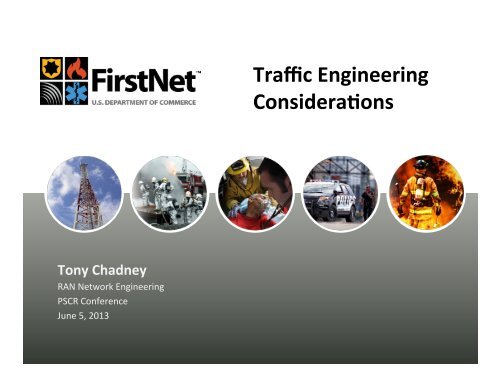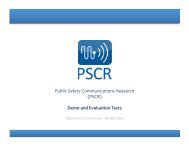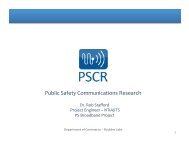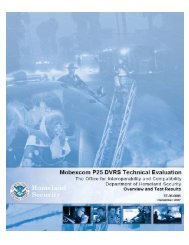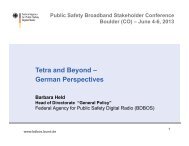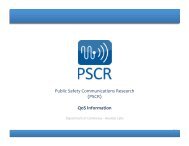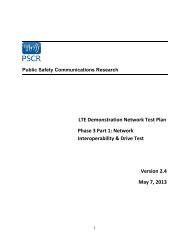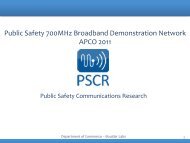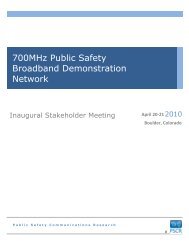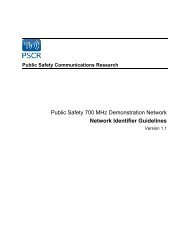Create successful ePaper yourself
Turn your PDF publications into a flip-book with our unique Google optimized e-Paper software.
Traffic Engineering Considera0ons Tony <strong>Chadney</strong> RAN Network Engineering <strong>PSCR</strong> Conference June 5, 2013
Network Objec0ves FirstNet objec0ves which are impacted by traffic characteris0cs: Coverage • Objec?ve: achieve the Band 14 coverage area which will be defined through the SLIGP process on a State-‐by-‐State and Territory-‐by-‐Territory basis Quality of Service (QoS) • Objec?ve: achieve Public safety grade Quality of Service on all voice, video and data applica?ons Priority • Objec?ve: ensure Public Safety traffic always has priority for admission and reten?on in Band 14. The major aspect is spectrum sharing considera?ons Capacity • Objec?ve: provide enough capacity for day-‐to-‐day use and incidents across the full coverage footprint June 5, 2013 For Official Use Only 2
Quality of Service Considera0ons LTE has extensive QoS feature set now being deployed and tested Technology status • Tier 1 carriers across the globe deploying and tes?ng QoS sensi?ve services, such as voice, which exploit the QoS feature set • Carriers relying on successful implementa?on to compete effec?vely with over-‐the-top services and accelerate 2G/3G switch off. FirstNet outlook • Expect to test and deploy QoS sensi?ve services and applica?ons using full LTE QoS feature set on Band 14. • Expect LTE industry commitment to ensure implementa?on is ul?mately successful, but will require diligence. Traffic engineering aspects • Tes?ng under load in trial and opera?onal condi?ons is required to characterize Radio Bearer capacity bearer requirements and the required radio condi?ons for successful opera?on. • Expect to provide feedback to vendors and standards bodies to improve robustness of service, spectrum efficiency and ease of planning. June 5, 2013 For Official Use Only 3
Priority – Admission aspects Two configura0ons of sharing under study Configura0on possibili0es • Secondary users can access Band 14 directly or indirectly • Indirect access is when Band 14 is used for overflow traffic from another Band class Public safety usersSecondary usersPublic safety usersSecondary users:direct access barredBAND 14 BAND 14 Direct access by secondary usersSecondary users attemptaccess from commercialband due to high loadOther LTE Band Indirect access by secondary usersJune 5, 2013 For Official Use Only 4
Priority – Admission aspects Direct Access versus Indirect Access Direct access for secondary users • Main considera?on is capacity of Physical Random Access Channel, (PRACH). Ini?al analysis shows LTE access capacity is 6-‐8 ?mes 3G, maybe more. Secondary users can be “throcled back” by up to 95% using Access Class Barring features. • Analysis ongoing of PRACH capacity including considera?on of the higher capacity PRACH configura?ons already in the 3GPP standard Indirect access for secondary users • Priority access to Band 14 for Public Safety is not impacted by overflow traffic acempts to Band 14. Overflow traffic acempts can use different PRACH preambles to those for direct access. No conten?on for PRACH resources between user types. • Further analysis of Direct Access is needed • Indirect Access does not have to experience conten0on between public safety and secondary users for access resources. June 5, 2013 For Official Use Only 5
Priority – Alloca0on and Reten0on Alloca0on and reten0on features of LTE give public safety priority The Alloca0on and Reten0on Priority feature (ARP) • ARP feature, in conjunc?on with Quality of Service Class Indicator (QCI),enables radio bearers needed for public safety to force release (preemp?on) of bearers carrying secondary users if eNodeB is at or near capacity. • ARP and QCI markings also prevent alloca?on of a radio bearer to secondary user as system nears capacity. Valida0on of opera0on and behavior • Needs tes?ng under load in trial and opera?onal condi?ons to ensure: – Bearer release of low priority traffic before conges?on onset or service QoS degrada?on on priority bearers. – New bearer alloca?on works properly and does not push eNodeB into conges?on. June 5, 2013 For Official Use Only 6
Traffic Engineering – Capacity Important ques0ons requiring answers What is the traffic profile of a Public safety user? How much video, voice and other applica0ons? • Es?mates have been developed by a number of sources. • Need opera?onal traffic data to determine the reality. How much capacity and where; day-‐to-‐day and for incidents? • Es?mates have been developed by a number of sources. • Requirements will depend on local condi?ons. • Some capacity needs can be an?cipated; others will be incident dependent and more uncertain. June 5, 2013 For Official Use Only 7
Traffic Engineering – Capacity Engineering for capacity Is there enough capacity for incidents? Reducing the uncertainty includes: • Prepara?on of a local, incident-‐focused traffic map which accounts for known risks and can be used to determine site placement and site configura?on. • Feed opera?onal experience and data back into the capacity planning process • Use of high power user equipment on vehicles: Simula?ons show capacity is increased on the uplink. • Use of four receiver antennas on vehicles for the downlink . Es?mated 50% capacity increase rela?ve to two antennas (assuming 2 Tx antennas at base sta?on). • Increased cell site density increases per user throughput due to less interference and higher signal level. • Mul?ple deployable types to supplement coverage and capacity, including units on first responder vehicles and transportable units. June 5, 2013 For Official Use Only 8
Band 14 LTE holds the promiseof delivering broadband service capacity and qualityto public safety userswhere they need it, when they need it.June 5, 2013 For Official Use Only 9


